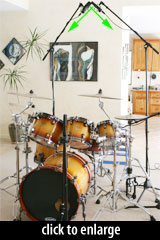How to Write a Microphone Review
Basic philosophy
The goal of a microphone review is to identify what a mic is good for.
Below you’ll find 1000 more words that try to explain that simple idea. Also there’s an outline for how to approach a mic review, which might be useful if you’ve never written one before (or never written a good one. 😉 ).
In other words…
To be clear, this means that the goal is not to declare whether a microphone is “good” or “bad.” These are subjective qualities that depend on the artist, instrument, room, engineer, arrangement, and song. No matter how deeply you believe some particular new microphone sucks, there are absolutely a lot of engineers who think it’s just exactly the right thing to use on boomy tenors, or steel snare drums, or hemp-coned guitar cabs, or whatever.
How you use the mic, and what you use it on, make or break the review. If you try the mic on one or two sources and it sounds great, you might be able to write a useful review. If you try the mic on one or two sources and you don’t like it on either, that’s probably not enough material for a useful review, because you haven’t found what the mic is good for.
How to start
An easy way to jump in is to describe the mic, accessories, and packaging. For reviews published on RecordingHacks.com, this is somewhat less necessary, simply because we would link the mic’s name to the mic’s profile page in the Microphone Database. That page will (theoretically) provide detailed information about the mic’s features and accessories.
Still, firsthand impressions about the mic are valuable, so that’s a great way to open the piece. And certainly if the accessories and features are especially intriguing/useful or maddening/crappy, feel free to dive into more detail.
The middle of the review
The meat of the review follows a cycle: describe the source, the placement, and the result.
Include audio samples whenever possible. You should get permission from the artist, of course. Be sure to name the artist and link to his/her website so review readers can find more of the artist’s work.
 Take some photos of mic placements, too. Even low-fi smartphone pictures add significant visual interest to the review.
Take some photos of mic placements, too. Even low-fi smartphone pictures add significant visual interest to the review.
Picking Sources
With a few exceptions, most mics can and should be used on most all sources, at least experimentally.
To those experiments, add the mic’s intended applications. If you’re reviewing a large-diaphragm condenser and you don’t try it on vocals, you’ve probably missed a key use for the mic. Similarly, reviewing a pencil mic without trying it on acoustic guitar does the mic a disservice.
Comparison mics
The best reviews include comparison audio tracks made with microphones that are likely to be familiar to a large percentage of readers. Choices vary by microphone type, but to name a few obvious examples, most people have used an SM57 on snare drum and guitar cabinet, the Audix D6 and AKG D112 on kick, and passive ribbons (like the Fathead) on guitar cabinet. The MK-012 is a widely-known drum overhead mic. AKG’s C414 in all its guises are popular all-purpose studio condensers.
The idea behind comparison audio tracks is to demonstrate the mic’s performance in ways that are difficult to describe, such as proximity effect, off-axis response, and directionality. While these factors would be difficult to discern in isolation, hearing a known mic in the same position in the same room allows meaningful conclusions to be drawn.
Wrapping Up
The conclusion is, for many, the hardest part of the review. If you’ve just spent 200-2000 words describing in detail how a mic sounds, stepping back to summarize that detail into a 3-sentence takeaway can be a challenge.
If you liked the mic, we recommend writing the single best thing you plan to say about the mic first. This is a 1-sentence statement. The pithier, the better. If you liked a mic and can write a quotable sentence saying so, your review might indeed be quoted by the manufacturer — a win for you, a win for them, and a win for your humble publisher.
Once that sentence is finished, work it into a longer conclusion. One to two short paragraphs is an adequate length.
The mic’s street price can be appropriately considered here. Price is certainly part of the decision for the buyer; it might as well be for the reviewer too.
Here are some questions that might guide the crafting of the conclusion:
- Is the mic a “utility” device, good on many sources, or a color/specialty mic?
- Is the mic especially good on a particular source?
- Is the mic a good value?
- Are the accessories adequate?
- Who should buy this mic — home/project studios, commercial studios, radio/broadcast media, artists, performers?
Bonus points
Your review will find a bigger and broader audience if you can identify the microphone’s performance characteristics in a way that benefits its users. That is, if in the process of testing the mic you’ve figured out ways to use it that are especially rewarding, then your review can become an advanced user’s guide for the mic — something people will read and pass along even after they’ve made a purchase decision.
For example:
- How does the mic respond to placement relative to the source — does it prefer to be close, back, or distant?
- How does the mic respond to off-axis sounds?
- Is the mic’s pickup pattern wider or tighter than comparable models?
- Does it favor loud sources or quiet?
- Does it sound especially good with a specific instrument or placement?